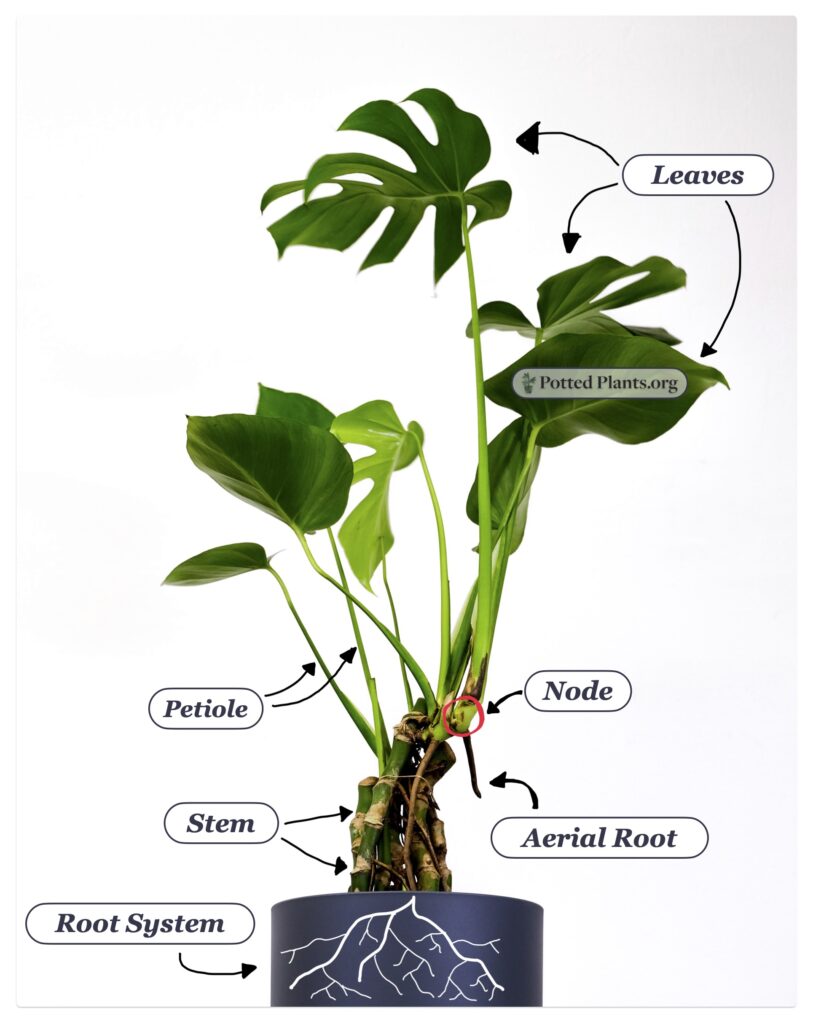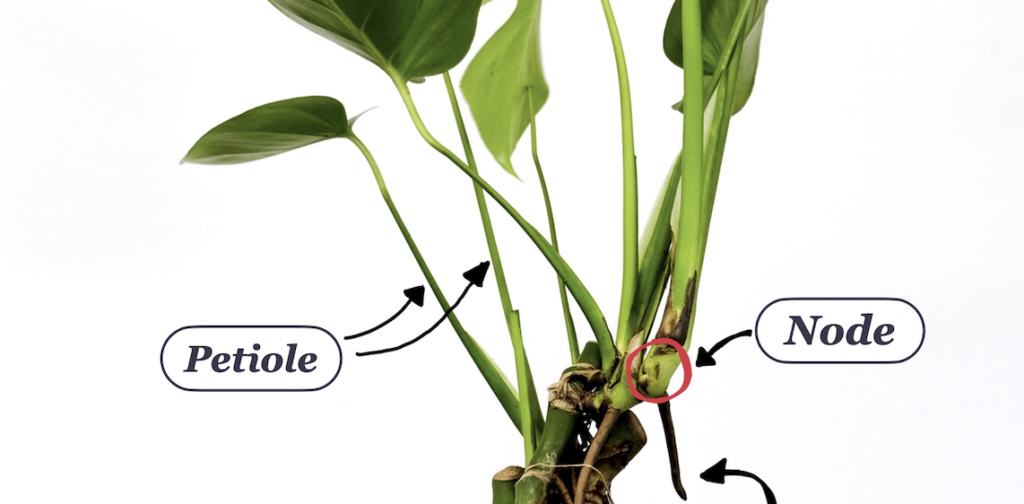Plants come in so many different shapes and sizes. Whether it’s a towering Fiddle Leaf Fig, a vining Philodendron Brasil, or a stunning Monstera Deliciosa, these plants have unique characteristics that make them iconic. Interestingly, these plants – and so many more – share common plant anatomy structures. Understanding these structures, will give you a better understanding of their roles in plant development, propagation and overall health.

Root System
Our anatomy exploration starts at the bottom structure of the plant: the root structure. The root system anchors the plant and provides water and nutrients extracted from the soil. Healthy roots firmly hold the plant upright, allowing for new growth, and quickly soak up water to provide needed hydration.
Over time, a plant’s root network may become root-bound: its roots growing so much and so dense, that they can no longer grow and must be repotted into a new container.
Another common issue is root rot: a bacterial and fungus infection of roots. Root rot is caused by overwatering that forces roots to sit in stagnant water. Bacteria, pests, and fungus can feed on the roots which can eventually lead to the death of the plant.
Stems
Connected to the root will be the main plant stem. Think of this as the spinal cord of your plant – the central structure that connects all other pieces. Stems tend to grow in segments called Nodes (see below) that represent a modular piece of your plant.
Over time, your plant will grow its stem in the form of new nodes from which leaves and aerial roots may sprout. For most plants, propagation can only be successful if a piece of the node or stem is included from the host plant.
Nodes
Plant nodes are modular sections of the stem. For vining plants like pothos, calathea, or philodendrons, nodes are the visible segments of the main stem, marked by branching leaves or the small aerial roots that form at the node base that make each node a self-contained segment of the plant that can form a completely new plant if it’s removed from the mother plant.
Plants that follow a more tree-like shape like the Fiddle Leaf Fig or the Ficus Tineke have a trunk in place of a stem, but grow with a similar node structure. On these plants, you can see nodes as small bumps on the stem, usually where a leaf shoot is located. Similar to vines, upright trees with nodes can also be propagated, as long as at least one complete node segment is removed from the host plant.
Aerial Roots
Vining plants that follow a node structure will also produce small aerial roots. Aerial roots help anchor vines to host plants as they climb in the jungle. Beyond structural support, they are also responsible for tapping sources to share water and nutrients to the plant from sources in the jungle canopy. Home growers sometimes use a moss pole to “teach” aerial roots to grow upwards, creating large and dramatic plant displays. Others choose to remove these roots for a cleaner look, as this will not harm the plant.
Petiole
The petiole is the part of the plant that connects the main stem with the leaves. Petioles and stems look so similar that many people confuse the two – especially with new leaves since the parts of the plant may not be as defined. But where the stem has the responsibility of supporting the entire plant as it grows, petioles are simple connectors to relay nutrients and energy between the leaves and the main plant stem.
It’s important not to tie or stake petiole segments when shaping your plant. Unlike the stem, the petiole aren’t strong enough to provide structural support. Staking or tying a vine by the petiole will likely cause the leaf to die.
Petioles vary in size depending on the plant. For calatheas like Prayer Plants, the petiole is a minor part of the plant. It becomes more defined for pothos and philodendron vines, and on larger plants like the Monstera, the petiole can look as big as the stem itself.
Leaves
The most easily-identifiable part of plant anatomy is the leaf. Leaves come in different shapes, sizes and colors – even among plants in the same family. Leaves are responsible for providing energy to the rest of the plant via photosynthesis, and the darker the leaves, the more efficient your plant will be at converting light into energy.
The first signs of plant distress comes through leaf changes. Leaves droop or turn brown if they are too dry or receiving too much sunlight, or begin to yellow if they are over-watered. Small white marketings on the surface or undersides can also highlight infestations from spider mites or other pests. Paying careful attention to the leaves will help you stay ahead of your plant’s needs.
For any plant, one of the best things you can do for your leaves is to regularly wipe them down with a damp cloth. Even the cleanest homes will have some dust buildup that will make your plant less effective at capturing sunlight. By regularly cleaning your plant’s leaves, you’ll keep them looking beautiful, and producing energy to help drive long-term growth.
Plant Anatomy: Key Takeaways
Plants are complex living structures. Understanding their basic structures will help plan for their long-term health and also increase the success if you’re interested in propagation to make new plants.

